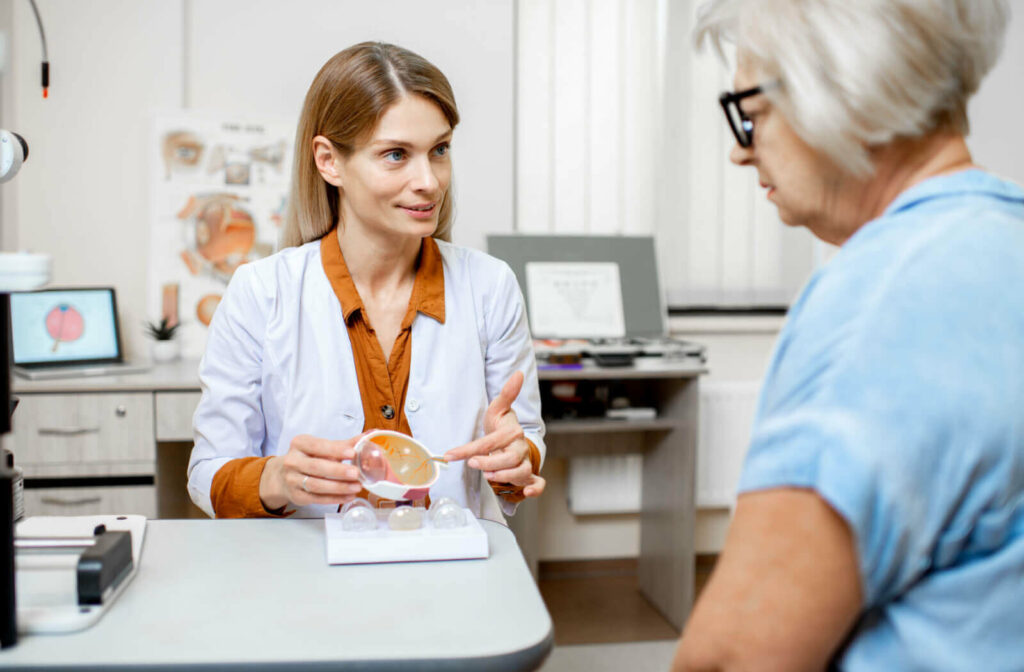Eyesight is one of our most important senses, yet it can be affected by many different conditions. Some common ones affecting people of all ages are myopia and hyperopia. These two conditions can cause similar symptoms, such as blurred vision and difficulty focusing. Still, they affect your vision in almost opposite ways.
Myopia causes blurry distant vision, while hyperopia causes nearby objects to appear out of focus.
Both can be corrected with glasses or contact lenses, though they require different prescriptions. Your local optometrist is happy to determine your prescription with a comprehensive eye exam and provide valuable information on keeping your vision healthy.
How Do We See?
It’s helpful to know how your eyes work to understand the difference between myopia and hyperopia. The eye is composed of several parts that work together to create sight:
- The cornea is the transparent outer layer that protects the eye and helps focus light.
- The iris is the coloured part that regulates the amount of light entering the eye.
- The pupil is the black circle in the center of the iris that widens or shrinks according to the amount of light.
- The lens is a flexible structure that changes shape to adjust the focus of light on the retina.
- The retina is the layer at the back of the eye that contains millions of light-sensitive cells to convert light into electrical signals.
- The optic nerve takes these electrical signals to the brain, where they’re interpreted as images.
In a healthy eye, light rays are focused directly onto the retina. For people with myopia or hyperopia, their eyes or corneas are irregularly shaped. Myopia means your eye has grown too long or the cornea is too curved. Hyperopia means your eye is too short or the cornea is too flat.
What Is Myopia?
Myopia, also known as nearsightedness, is one of the most common vision conditions in the world, with 30% of the population having it to some extent. It causes distant objects to appear blurry while nearby objects remain clear.
Myopia is often first diagnosed during childhood, usually around 6–7. It can significantly impact a child’s ability to learn, socialize, and enjoy activities like sports.
Several factors can increase a child’s risk of developing myopia, including:
- Having parents with myopia
- Not having enough time outdoors
- Prolonged use of electronic devices
Children with Myopia
Myopia can significantly impact children’s academic performance and overall quality of life. Nearsighted children may need help to see the board clearly in the classroom, making it difficult to take notes or follow along in lessons.
This can lead to frustration, decreased motivation, and even poor academic performance. Additionally, nearsightedness can impact a child’s ability to engage in sports or other recreational activities, leading to social isolation or a lack of physical activity.
It can be difficult for children to tell you if they have myopia. They may not have the language to explain what they’re experiencing or don’t realize that they don’t see correctly. Here are some signs your child may have myopia:
- Complaints of discomfort or blurred vision
- Short attention span
- Frequent blinking
- Trouble seeing the board in class
- Headaches
- Covering one eye or tilting the head to one side
What Is Hyperopia?
Hyperopia, also known as farsightedness, can be considered the “opposite” of myopia—even though it can affect your lifestyle similarly. It’s a condition in which an individual can see far away objects clearly, but objects that are close up appear blurred. This occurs because a shorter-than-normal eyeball causes light to focus behind the retina.
This condition can affect people of all ages, from young children to seniors. If you have hyperopia, you may experience difficulties reading, crafting, sewing, or doing any activity requiring close vision.
Experts are still researching the exact causes behind hyperopia. It may be inherited from your parents or caused by the environment. Many people can have some amount of hyperopia and never know it! It usually only becomes a problem if it impacts your daily activities.
Treating Refractive Errors
The most common treatment for refractive errors is corrective lenses, including glasses and contact lenses. Glasses are popular for children, as they’re relatively easy to use and maintain. Contact lenses may also be a suitable option for older children or teenagers who are more responsible and able to handle them safely.
Another treatment option is refractive surgery, which uses lasers to alter the shape of the cornea. This may be appropriate for adults whose refractive errors have stabilized. You can talk with your optometrist to learn if you’re a candidate for LASIK or PRK.
Myopia Management
One of the most significant differences between myopia and hyperopia is that myopia can progress through childhood, worsening until they reach about 20. Once the damage from myopia is done, it can’t be reversed. By slowing its progression, you can help your child avoid dangerous eye diseases later in life caused by high myopia.
Myopia management is a treatment program that can help slow myopia’s progression through prescription glasses or contacts, atropine drops, and environmental changes.
Eye Care for All Ages
Whether you’re living with myopia or hyperopia, keeping your eyes healthy is essential and requires regular eye checkups. Optometrists recommend children have an eye exam annually, adults over 20 have an eye exam at least every 2 years, and seniors 65+ should go back to having annual eye exams.River Heights Eye Care offers child and adult eye exams to detect refractive errors. Whether your vision is blurry up close or far away, our expert team can help you through your vision correction options. Book an appointment, and let’s start caring for your eyes today.


